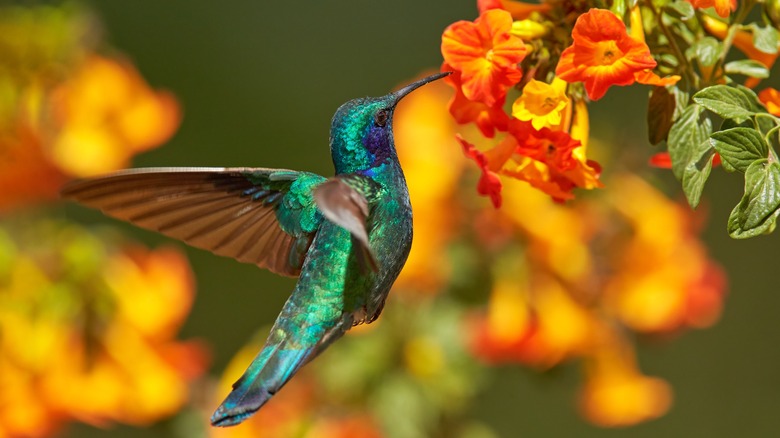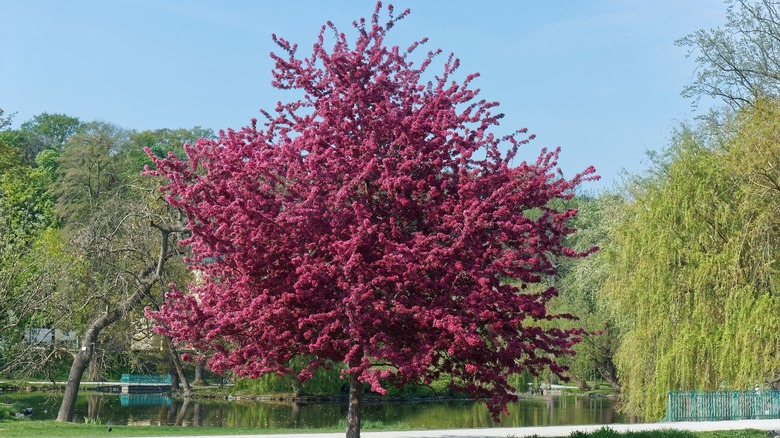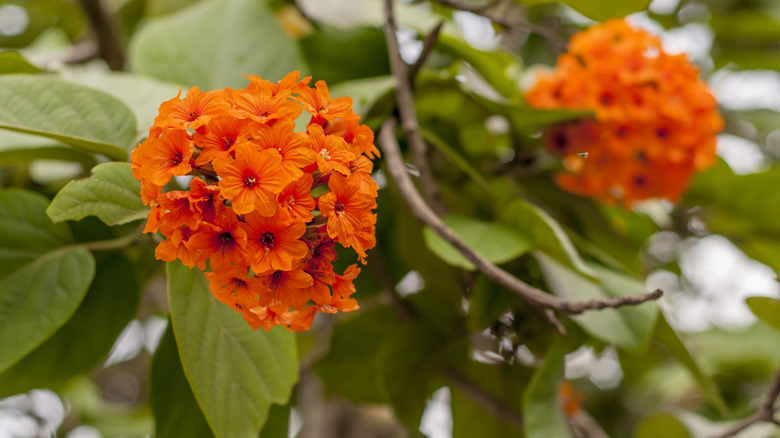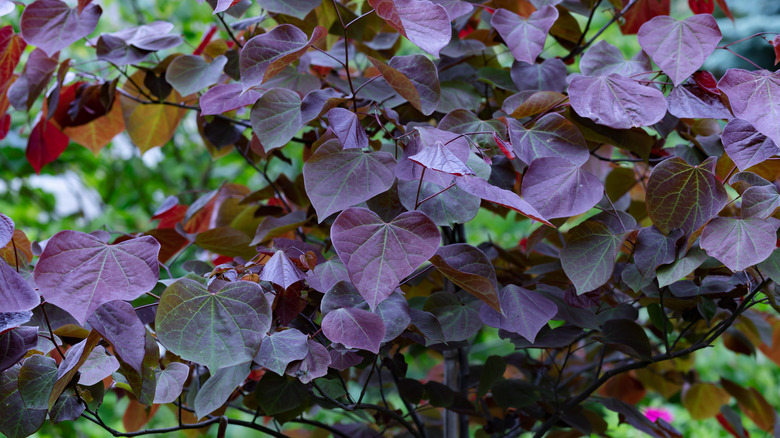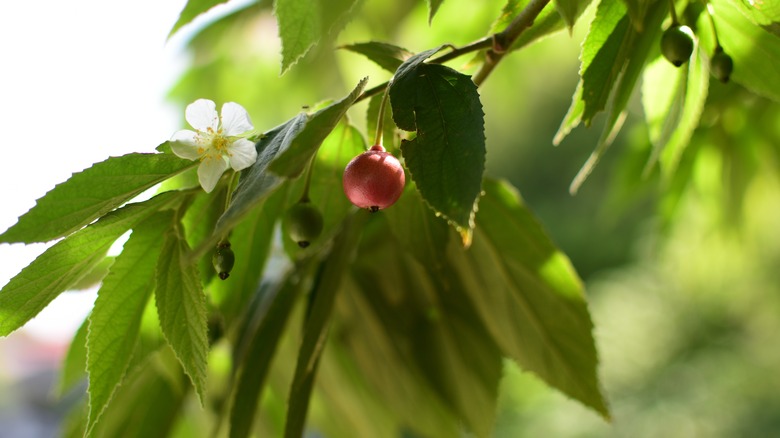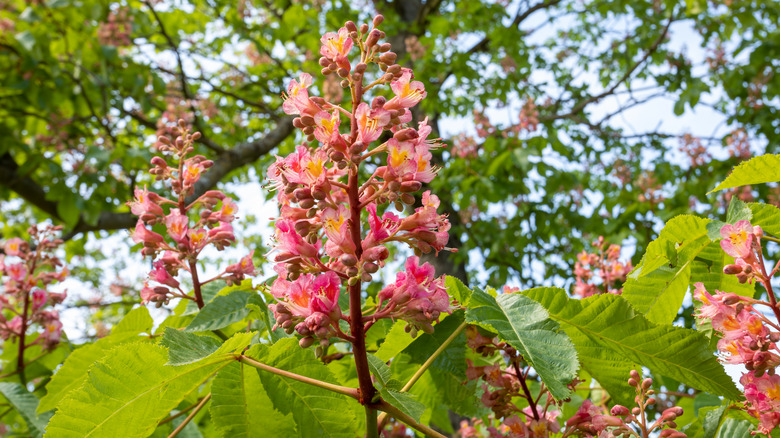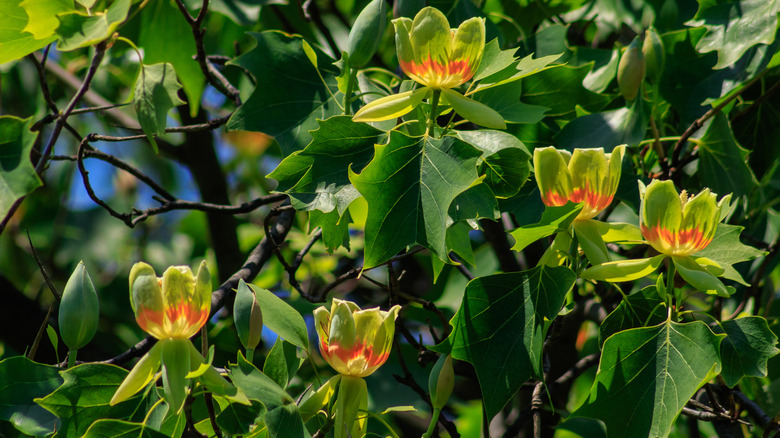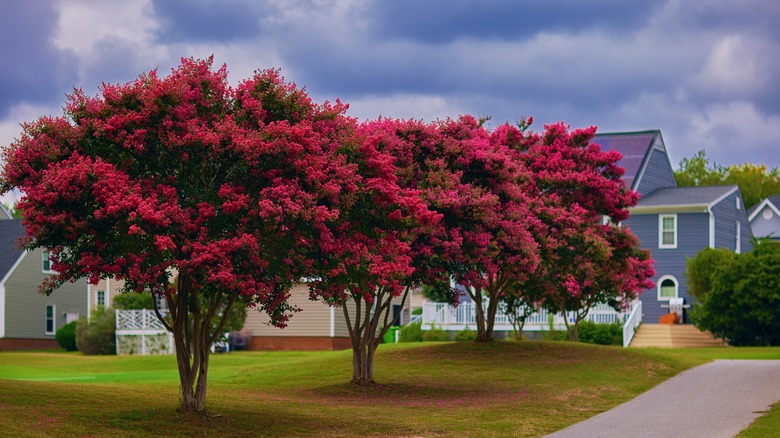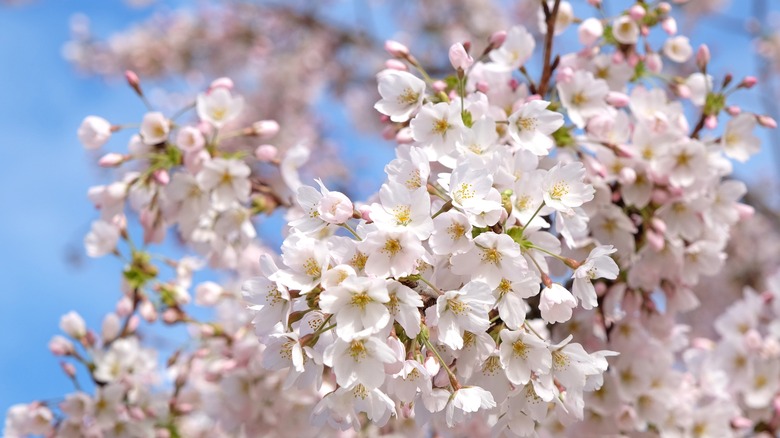8 Flowering Trees That'll Attract Hummingbirds To Your Yard And Garden
Hummingbirds are stunning creatures of flight, known for the sound their wings make as they flap up to 80 times per second. According to the American Bird Conservancy, the United States is graced with 15 different hummingbird species, although there are more than 360 species across the globe. These tiny birds are not only fascinating to observe, but they are also excellent pollinators. Attracting them to your yard and garden will benefit the other plants growing on your property, as they stop by a whopping 1,000 flowers each day for a sip of nectar.
One way to draw hummingbirds to your yard and garden is to plant flowering trees that the birds are known to frequent. Some trees offer colorful flowers that are filled with tasty nectar, while others provide shelter. There are even flowering trees that hummingbirds visit to search and dine on insect pests, proving the trees with natural pest control. In addition to operating as a haven for hummingbirds, the trees themselves are sure to provide your outdoor space with beauty and charm when in bloom.
Draw hummingbirds with a crabapple tree (Malus coronaria)
A crabapple is a colorful tree to plant in your yard if you want to attract hummingbirds. The tree not only draws in the feathery creatures with its delightful pink blossoms, which emit a pleasant, sweet scent, but it also provides tiny fruits that resemble miniature apples for the hummingbirds to eat. Although the fruits are sour, the birds seem to prefer their nectar. As an added bonus, landowners can pick some of the crabapple tree's fruit and use it to make cider.
You'll find crabapples grow best in U.S. Department of Agriculture Plant Hardiness Zones 4 through 8. They require a well-draining soil that is kept moist; however, they can tolerate dry soil on occasion. Plant the tree in an area that receives either full sun or partial shade and make sure the spot is large enough to accommodate the tree's growth. Crabapple trees can reach heights and widths of up to 30 feet. Keep watch for pests, diseases, and predators, as this tree is susceptible to a variety of problems. A few of these include aphids, rust, and deer. A word of warning: Some crabapple varieties are considered invasive in certain regions, such as the Japanese flowering crabapple, which is invasive when planted in the Northeast.
Entice hummingbirds with a Geiger tree (Cordia sebestena)
Another spectacular tree that is sure to bring a charm of hummingbirds to your landscape is the Geiger tree. This tree offers the birds a multitude of benefits. It captures their attention with its bright orange flowers that erupt at the tips of the tree's branches and gives them a place to rest and seek shelter. That's thanks to the structure of the branches and their leaves, as their formation provides filtered sunlight for the creatures of flight. Homeowners can choose to plant this tree in their garden or set it out on a patio in a container.
Named after Key West pilot John Geiger, the Geiger tree is a tropical plant that will only thrive in U.S. Department of Agriculture Plant Hardiness Zones 10B through 11. With proper care, the tree can reach a height of 30 feet and a width of 25 feet. A Geiger tree is capable of handling both alkaline and acidic soils, as long as the soil drains well. You'll need to plant it in a location that receives full sun to partial shade. While the tree is resistant to most diseases, you will need to keep a watch for such pests as mites, scales, and the Geiger beetle. Additionally, this tree is not frost tolerant and should not be planted outside of the recommended USDA Zones.
Lure hummingbirds with an Eastern redbud (Cercis canadensis)
Stunning pink or purple flowers, depending on the cultivar, adorn the eastern redbud and entice hummingbirds to pay a visit. The tree's heart-shaped leaves are also quite attractive, but it's the cluster of flowers that hummingbirds love. The blossoms erupt close to the branches and extend outward, making it easier for the birds to perch and dine on the flowers' flavorful nectar.
As long as you live in U.S. Department of Agriculture Plant Hardiness Zones 4 through 9, you can grow an eastern redbud in your yard. Just like the Geiger tree, the eastern redbud is able to handle a variety of soils, including soils with an acidic and alkaline pH, as long as the soil drains well. The location you choose for planting should receive full sun or partial shade and have enough space for the tree to reach a height of 30 feet and a width of 35 feet. In addition to keeping the soil moist, you'll need to watch for verticillium wilt, canker, leaf spots, borers, webworm, and scale insects. According to Pennsylvania State University, eastern redbuds pair well with both daffodils and tulips.
Grab the attention of hummingbirds with a strawberry tree (Muntingia calabura)
Grown as both a garden and patio plant, strawberry trees are an excellent addition for bird lovers, as they not only attract hummingbirds, but other bird species as well. The white blossoms stand out among the dark green leaves, grabbing the attention of the winged animals, while the cranberry-shaped fruit provides a delicious meal, comparable to that of a fig. In fact, landowners can use some of the fruit themselves to make everything from jam to wine.
Strawberry trees are best grown in U.S. Department of Agriculture Plant Hardiness Zones 8 through 11, but can be cared for on patios in zones as low as 4. When proper growing requirements are met, this tree grows rapidly, reaching both a height and width of up to 30 feet. Set the tree in a location that receives full to partial sun and ensure that the soil is well-draining with a pH between 5.6 and 8.5. Water only when the top of the soil begins to feel dry, as strawberry trees are susceptible to disease when overwatered. Watch for aphids and mealybugs, which are common pests of the tree.
Captivate hummingbirds with a red buckeye (Aesculus pavia)
While the red buckeye, also commonly known as the firecracker plant, can be grown as a tree, it can also be pruned as a bush. No matter how you decide to grow the red buckeye, you're sure to attract hummingbirds to your outdoor space. The tree's vibrant red blossoms that stand erect are a huge draw to the beautiful birds, who have beaks long enough to draw nectar from within the tubular-shaped flowers. The blossoms also interest butterflies, while the fruit entices squirrels, making them an excellent choice for nature lovers.
Grown best in U.S. Department of Agriculture Plant Hardiness Zones 4 through 8, red buckeye trees prefer a well-draining soil with a neutral pH between 6.0 and 8.0. Set the tree in an area with partial shade and make sure the soil is kept moist. According to North Carolina State University, red buckeyes can withstand full sun; however, this makes the tree susceptible to leaf scorch. When planting, keep in mind that the tree may reach heights of 25 feet with a width of up to 20 feet. Pests are not typically a problem, but you will need to watch for the fungal disease leaf blotch. Warning: Many parts of the red buckeye are poisonous to humans. This tree would not be a good choice in homes with children and pets.
Tempt hummingbirds to visit your yard with a tulip tree (Liriodendron tulipifera)
If you're searching for a low-maintenance tree to add to your yard or garden that will capture the attention of hummingbirds, look no further than the tulip tree. Named for its tulip-shaped flowers, which are bright yellow and orange in color, the tulip tree offers shelter for these delightful birds of flight. In addition to pollinating the blossoms, hummingbirds feast on the flowers' nectar. When the birds are especially hungry, they'll also dine on any insects that may be invading the tree.
Before opting for a tulip tree, you'll need to consider both the tree's growing zones and size at maturity. Tulip trees are hardy in U.S. Department of Agriculture Plant Hardiness Zones 4 through 9 and can grow as large as 120 feet tall and 60 feet wide. If you meet these criteria, make sure the soil is well-draining and acidic, with a pH of 6.0 or higher. Ensure the tree has access to full sun and that the soil is kept moist. Unfortunately, the tree is prone to a variety of insect and disease problems, including aphids, scale, powdery mildew, canker, leaf spot, and sooty mold.
Hypnotize hummingbirds with a muskogee crape myrtle tree (Lagerstroemia indica x fauriei 'Muskogee')
Not only do the striking lavender blooms of the muskogee crape myrtle tree draw hummingbirds to a garden, but they also entice butterflies and bees. The flowers have a pleasant aroma and plenty of nectar for your favorite bird species. What's even better is that the crape myrtle blooms for a full six months, allowing you to enjoy watching the tiny hummingbirds much longer than you would with many of the other trees listed here. The tree also grows quickly, so you won't have to wait long for it to reach maturity.
Crape myrtles can grow up to 30 feet tall with a spread of 15 feet and should be planted in U.S. Department of Agriculture Plant Hardiness Zones 6 through 9. They require full sun and a well-draining soil. Once established, however, you won't need to water the tree. It is drought-tolerant and able to thrive on rainwater alone. Muskogee crape myrtles are resistant to diseases like powdery mildew, but they can be plagued with aphids, which may cause sooty mold.
Dazzle hummingbirds with a weeping Yoshino cherry tree (Prunus x yedoensis pendula)
Properties with smaller backyards may want to consider going with the weeping Yoshino cherry tree, as it typically reaches a height and width of just 20 feet. This eye-catching tree produces single or double flowers that range in color from white to pink, all of which attract hummingbirds. Songbirds also enjoy visiting weeping Yoshino cherry trees, providing you with complimentary seasonal music.
With the Yoshino cherry tree, you have the option of planting outdoors in the ground in U.S. Department of Agriculture Plant Hardiness Zones 5 through 8, or on the patio in a container. It does well with a variety of soil types, as long as the soil is well-draining. Make sure the Yoshino cherry tree has access to full sun or partial shade and that you keep the soil moist at a depth of 3 inches. You'll need to protect the tree from a host of pests and diseases, such as deer, voles, Japanese beetles, black knot, and verticillium wilt. Note that Yoshino cherry trees contain a compound known as cyanogenic glycosides, which is toxic to pets and humans when ingested.
